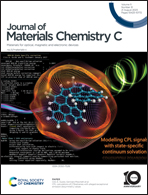Effect of stoichiometry on the resistive switching characteristics of STO resistive memory
Abstract
Herein, SrTiO3 (STO) resistive memories with write-once-read-many-times (WORM) function were fabricated. The STO resistive switching (RS) layers were deposited at a sputtering power in the range of 40–120 W and oxygen flow rate in the range of 0–3 sccm. Without the addition of oxygen, the deposited STO films were non-stoichiometric, and the Sr/Ti ratios were all higher than unity. The ON/OFF current ratio of the STO memory deposited at 40 W was 106. When the power increased from 40 W to 120 W, a decrease in the Sr/Ti ratio was obtained. The stoichiometry of the STO film was closer to unity. Moreover, the memory showed a higher ON/OFF current ratio of 5 × 106. Oxygen was further introduced during the sputtering process to adjust the STO stoichiometry. The Sr/Ti ratio decreased from 1.54 to 1.04 when STO was deposited at an oxygen flow rate of 1 sccm. The stoichiometric STO RS layer resulted in a significantly higher ON/OFF current ratio of 2 × 108. The STO film became nonstoichiometric, where the Sr/Ti ratio was lower than unity when the oxygen flow rate further increased to 3 sccm. The data storage capability of the STO memory was investigated. Moreover, stability tests were performed at 85 °C to study the lifetime of the device. Temperature-dependent measurement was performed to verify the validity of the filamentary mechanism. Also, the carrier conduction mechanism and energy band diagram were studied and illustrated.



 Please wait while we load your content...
Please wait while we load your content...